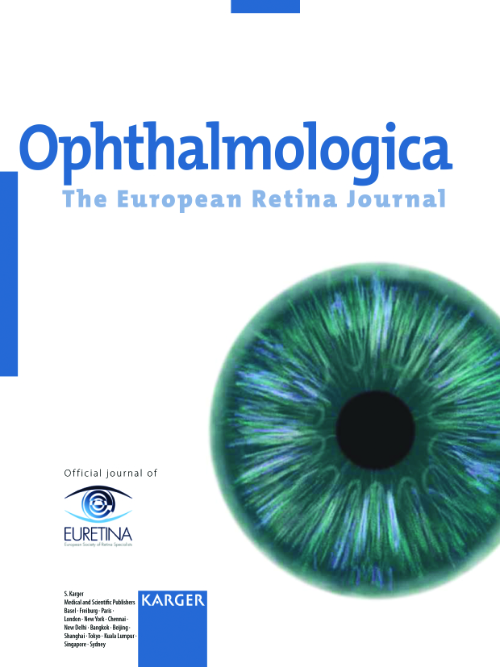Ophthalmologica Highlights
VOL: 244 ISSUE: 2

Sebastian Wolf
Published: Tuesday, June 1, 2021
 APELIN-13 A POTENTIAL BIOMARKER FOR AMD
Elevated serum concentrations of the peptide apelin-13 may serve as a biomarker for both dry-type and neovascular-type age-related macular degeneration (AMD), according to the findings of a new study. The study involved 84 patients and showed that the mean serum level of apelin-13 was only 379.31pg/mL in 33 healthy controls, compared to 586.47pg/mL in 24 patients with dry-type AMD (p=0.04) and 622.18 pg/mL in 27 patients with treatment-naïve neovascular AMD (p≤0.001). In addition, there was a negative correlation between the level of serum apelin and visual acuity (VA) and choroidal thickness.
E Vural et al, “Apelin-13: A Promising Biomarker for Age-Related Macular Degeneration?” Ophthalmologica 2021, volume 244, issue 2.
OCT-A PROVIDES INACCURATE DIAGNOSES
A new study suggests that the use of optical coherence tomography angiography (OCT-A) in the diagnoses and assessment of retinal diseases is marred by considerable variability in interpretation, with mediocre rates of accuracy and agreement between clinicians. In the study, 58 retinal specialists were asked to identify retinal findings and provide a diagnosis in a series of eight eyes with common retinal pathologies. When viewing OCT-A images alone, the overall rates of accurate diagnosis and identification of retinal findings were 37.4 % and 61.6%, respectively. There was no correlation between the accuracy of interpretation of OCT-A findings with length of experience or self-reported familiarity with OCT-A.
T Rabinovitch et al, “Evaluation of Accuracy and Agreement of Optical Coherence Tomography Angiography Interpretation of Common Retinal Findings and Diagnoses”, Ophthalmologica 2021, volume 244, issue 2.
POORER VISUAL OUTCOMES WITH PHACOVITRECTOMY
Patients who undergo phacovitrectomy combined with membrane peeling for idiopathic epiretinal membranes may be at an increased risk of retinal sequalae compared to those who undergo vitrectomy and epiretinal peeling alone, according to a new retrospective study. The analysis of the outcomes of 84 patients showed that those who underwent phacovitrectomy with membrane peeling had a nonsignificant trend toward a higher intraretinal cystoid changes (p=0.5) and early transient macular oedema (p=0.186), compared to those who underwent vitrectomy and membrane peeling alone. The final best-corrected distance visual acuity (BCVA) three months after surgery was significantly lower among patients with new postoperative intraretinal cystoid changes compared to patients without (p=0.016).
C Leisser et al, “Effect of Phacoemulsification on Outcomes after Vitrectomy with Membrane Peeling regarding New Intraretinal Cystoid Changes and Transient Macular Edema”, Ophthalmologica 2021, volume 244, issue 2.
Ophthalmologica is the peer-reviewed journal of EURETINA
APELIN-13 A POTENTIAL BIOMARKER FOR AMD
Elevated serum concentrations of the peptide apelin-13 may serve as a biomarker for both dry-type and neovascular-type age-related macular degeneration (AMD), according to the findings of a new study. The study involved 84 patients and showed that the mean serum level of apelin-13 was only 379.31pg/mL in 33 healthy controls, compared to 586.47pg/mL in 24 patients with dry-type AMD (p=0.04) and 622.18 pg/mL in 27 patients with treatment-naïve neovascular AMD (p≤0.001). In addition, there was a negative correlation between the level of serum apelin and visual acuity (VA) and choroidal thickness.
E Vural et al, “Apelin-13: A Promising Biomarker for Age-Related Macular Degeneration?” Ophthalmologica 2021, volume 244, issue 2.
OCT-A PROVIDES INACCURATE DIAGNOSES
A new study suggests that the use of optical coherence tomography angiography (OCT-A) in the diagnoses and assessment of retinal diseases is marred by considerable variability in interpretation, with mediocre rates of accuracy and agreement between clinicians. In the study, 58 retinal specialists were asked to identify retinal findings and provide a diagnosis in a series of eight eyes with common retinal pathologies. When viewing OCT-A images alone, the overall rates of accurate diagnosis and identification of retinal findings were 37.4 % and 61.6%, respectively. There was no correlation between the accuracy of interpretation of OCT-A findings with length of experience or self-reported familiarity with OCT-A.
T Rabinovitch et al, “Evaluation of Accuracy and Agreement of Optical Coherence Tomography Angiography Interpretation of Common Retinal Findings and Diagnoses”, Ophthalmologica 2021, volume 244, issue 2.
POORER VISUAL OUTCOMES WITH PHACOVITRECTOMY
Patients who undergo phacovitrectomy combined with membrane peeling for idiopathic epiretinal membranes may be at an increased risk of retinal sequalae compared to those who undergo vitrectomy and epiretinal peeling alone, according to a new retrospective study. The analysis of the outcomes of 84 patients showed that those who underwent phacovitrectomy with membrane peeling had a nonsignificant trend toward a higher intraretinal cystoid changes (p=0.5) and early transient macular oedema (p=0.186), compared to those who underwent vitrectomy and membrane peeling alone. The final best-corrected distance visual acuity (BCVA) three months after surgery was significantly lower among patients with new postoperative intraretinal cystoid changes compared to patients without (p=0.016).
C Leisser et al, “Effect of Phacoemulsification on Outcomes after Vitrectomy with Membrane Peeling regarding New Intraretinal Cystoid Changes and Transient Macular Edema”, Ophthalmologica 2021, volume 244, issue 2.
Ophthalmologica is the peer-reviewed journal of EURETINA